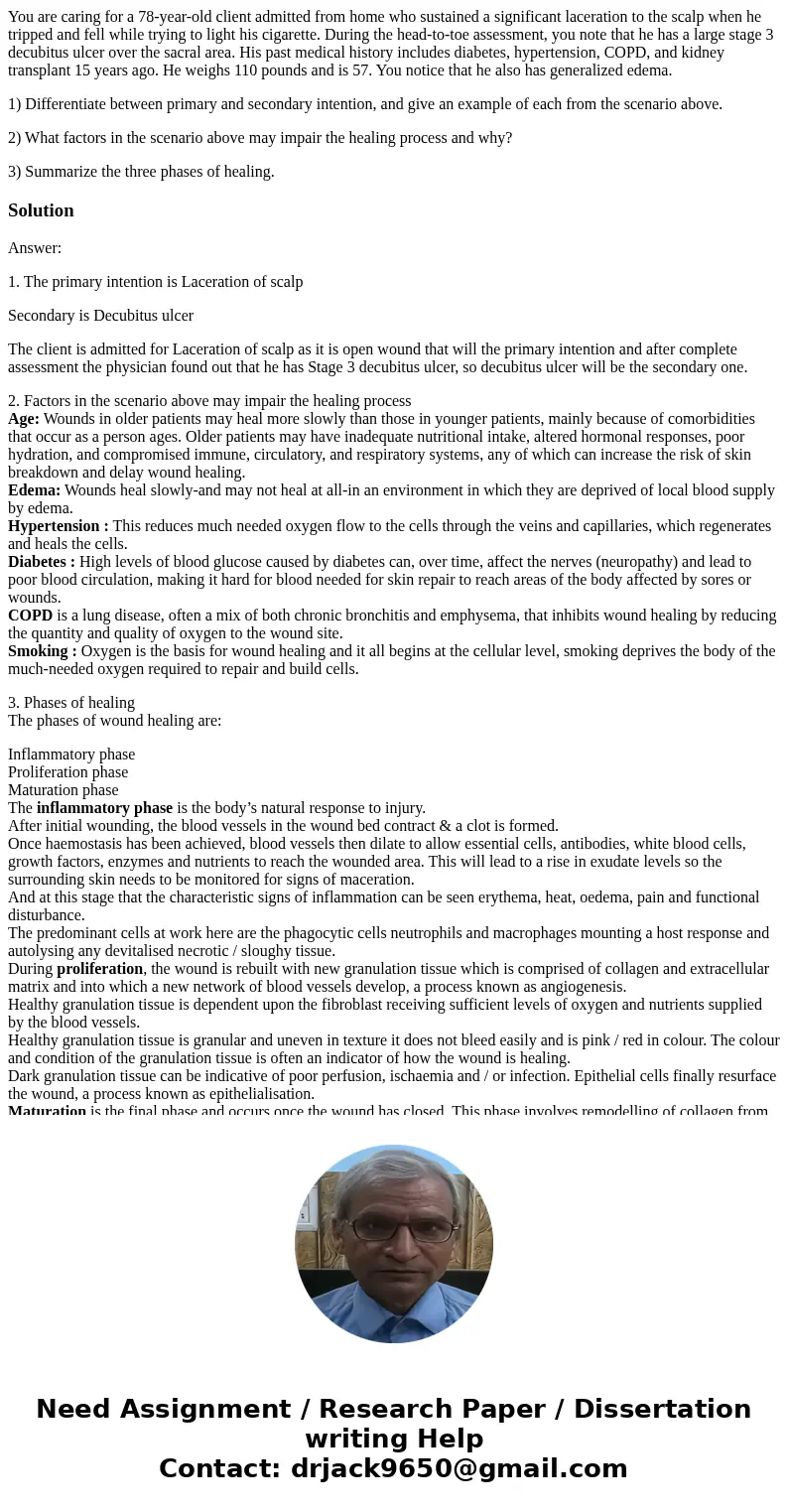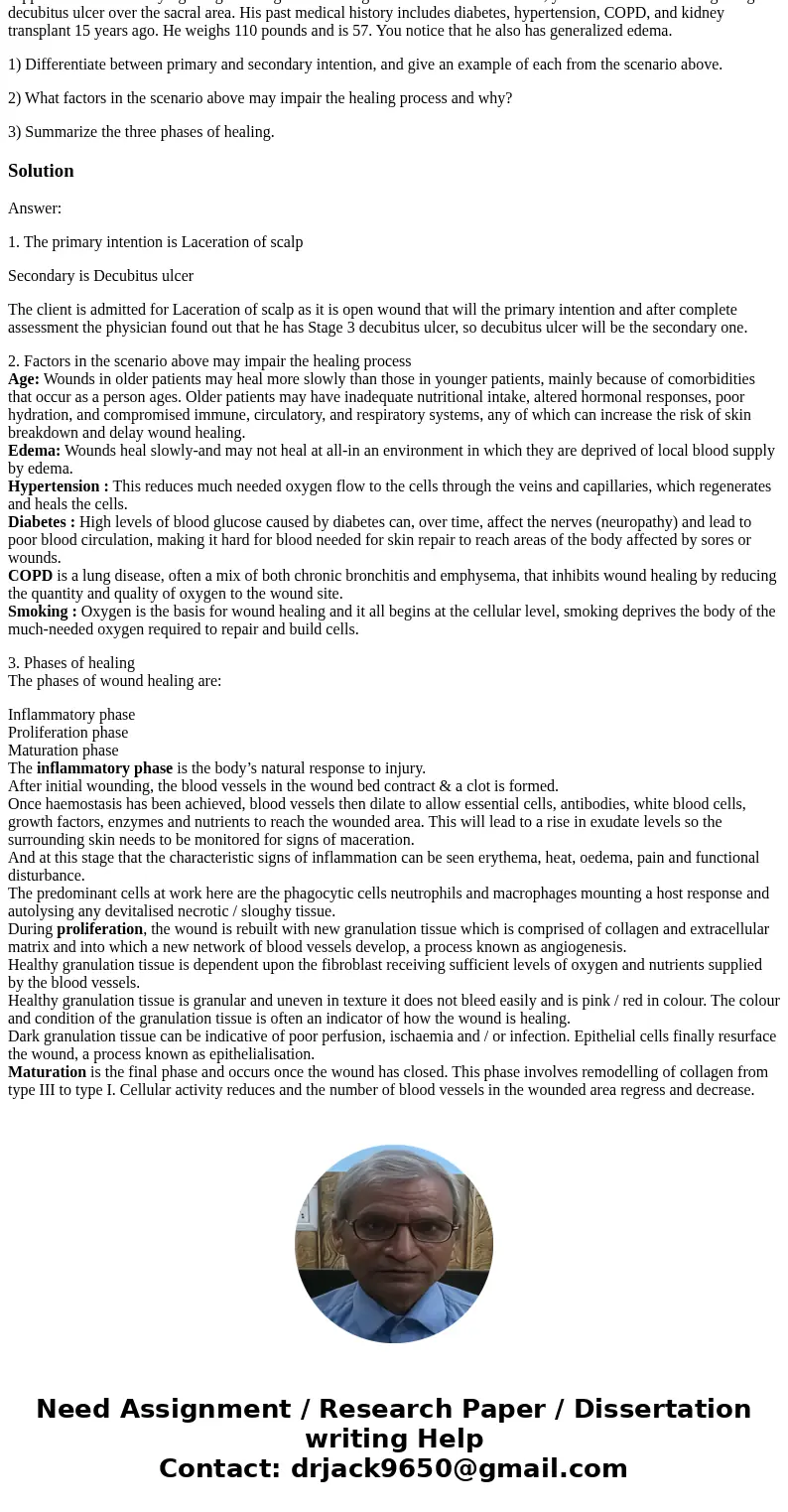You are caring for a 78yearold client admitted from home who
You are caring for a 78-year-old client admitted from home who sustained a significant laceration to the scalp when he tripped and fell while trying to light his cigarette. During the head-to-toe assessment, you note that he has a large stage 3 decubitus ulcer over the sacral area. His past medical history includes diabetes, hypertension, COPD, and kidney transplant 15 years ago. He weighs 110 pounds and is 57. You notice that he also has generalized edema.
1) Differentiate between primary and secondary intention, and give an example of each from the scenario above.
2) What factors in the scenario above may impair the healing process and why?
3) Summarize the three phases of healing.
Solution
Answer:
1. The primary intention is Laceration of scalp
Secondary is Decubitus ulcer
The client is admitted for Laceration of scalp as it is open wound that will the primary intention and after complete assessment the physician found out that he has Stage 3 decubitus ulcer, so decubitus ulcer will be the secondary one.
2. Factors in the scenario above may impair the healing process
Age: Wounds in older patients may heal more slowly than those in younger patients, mainly because of comorbidities that occur as a person ages. Older patients may have inadequate nutritional intake, altered hormonal responses, poor hydration, and compromised immune, circulatory, and respiratory systems, any of which can increase the risk of skin breakdown and delay wound healing.
Edema: Wounds heal slowly-and may not heal at all-in an environment in which they are deprived of local blood supply by edema.
Hypertension : This reduces much needed oxygen flow to the cells through the veins and capillaries, which regenerates and heals the cells.
Diabetes : High levels of blood glucose caused by diabetes can, over time, affect the nerves (neuropathy) and lead to poor blood circulation, making it hard for blood needed for skin repair to reach areas of the body affected by sores or wounds.
COPD is a lung disease, often a mix of both chronic bronchitis and emphysema, that inhibits wound healing by reducing the quantity and quality of oxygen to the wound site.
Smoking : Oxygen is the basis for wound healing and it all begins at the cellular level, smoking deprives the body of the much-needed oxygen required to repair and build cells.
3. Phases of healing
The phases of wound healing are:
Inflammatory phase
Proliferation phase
Maturation phase
The inflammatory phase is the body’s natural response to injury.
After initial wounding, the blood vessels in the wound bed contract & a clot is formed.
Once haemostasis has been achieved, blood vessels then dilate to allow essential cells, antibodies, white blood cells, growth factors, enzymes and nutrients to reach the wounded area. This will lead to a rise in exudate levels so the surrounding skin needs to be monitored for signs of maceration.
And at this stage that the characteristic signs of inflammation can be seen erythema, heat, oedema, pain and functional disturbance.
The predominant cells at work here are the phagocytic cells neutrophils and macrophages mounting a host response and autolysing any devitalised necrotic / sloughy tissue.
During proliferation, the wound is rebuilt with new granulation tissue which is comprised of collagen and extracellular matrix and into which a new network of blood vessels develop, a process known as angiogenesis.
Healthy granulation tissue is dependent upon the fibroblast receiving sufficient levels of oxygen and nutrients supplied by the blood vessels.
Healthy granulation tissue is granular and uneven in texture it does not bleed easily and is pink / red in colour. The colour and condition of the granulation tissue is often an indicator of how the wound is healing.
Dark granulation tissue can be indicative of poor perfusion, ischaemia and / or infection. Epithelial cells finally resurface the wound, a process known as epithelialisation.
Maturation is the final phase and occurs once the wound has closed. This phase involves remodelling of collagen from type III to type I. Cellular activity reduces and the number of blood vessels in the wounded area regress and decrease.


 Homework Sourse
Homework Sourse